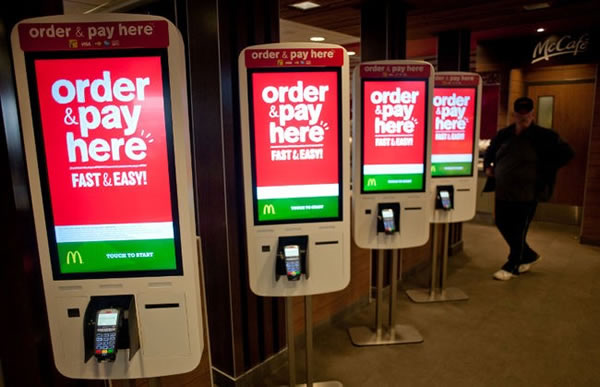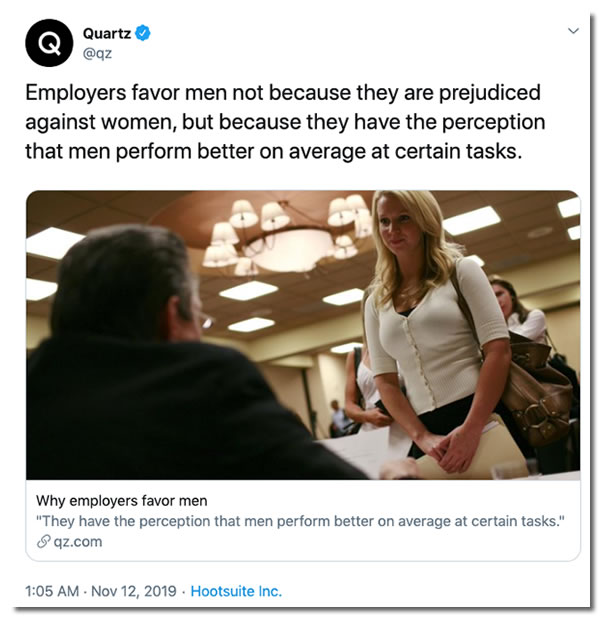
McKiosks are popping up in McDonald’s everywhere, but they don’t accept cash
The kiosks are part of renovations that McDonald’s has been pushing stores to adopt, with the lion’s share of the costs being paid by the franchisees. Business Insider reports that many restaurant owners have had to shell out as much as $750,000 per store for these upgrades.
Given that they make a considerable portion of McDonald’s target markets, the “unbanked” — people without a bank account or debit or credit card — account for about 6.5% of U.S. households. That’s 8.4 million people.
Many businesses are going cashless — here are the pros and cons

It’s not just big businesses that are going cashless. Even small mom-and-pop and hipster establishments (including Florida Eats, which recently opened on my neighborhood — and then closed soon after, despite being popular) are no longer accepting cash.
There are a number of reasons for going cashless:
- People buy more when paying with a card. Given the number of people who say they’re not “math people”, the abstract nature of paying with a card, versus the more concrete nature of handing over bills to a cashier, means that the amount paid seems less “real”.
- It makes accounting easier. If you’ve ever worked at a cash register, you know the pain of dealing with the amount in the cash drawer not lining up with the amount shown on its printout. Going cashless eliminates this problem: every transaction is properly accounted for.
- It’s convenient for both payer and payee. They’re no counting bills or change. Retailers report that it speeds up transactions, which increases throughput (the number of transactions you can do in a given amount of time).
- Cash makes you a target. Having to deposit a large amount of hard-to-trace currency at the end of each day is an opportunity for criminals. There are also risks in letting your employees deal with cash, especially in larger amounts.
There are downsides to going cashless:
- You’re going to pay credit card fees. These can be as high as 4%. Worse still is the fact that it doesn’t cost the banks that much to process credit cards — they’re just charging that rate because they can.
- You’ll lose some customers. Remember that 6.5% of people in the U.S. are “unbanked”, and if they make a significant portion of your customers and you don’t take cash, they’ll take their money elsewhere. Even among people with bank accounts, there are people who use cash for reasons such as privacy (which I’ll cover in a moment) or as a money management technique (one example: finance advisor Dave Ramsey’s envelope system).
- When the system goes down, how will you collect money? There are workarounds, and all of them are a pain.
Why I pay for fast food with cash: Data mining

I’m not a regular fast food customer, but there are times when it’s unavoidable. When that happens I pay in cash only, and it’s for an increasingly important reason: so that insurance companies can’t find out.
Companies are increasing their reliance on data mining for all sorts of things (that’s why I’ve been sharpening my Python and Jupyter Notebooks skills), including reducing risk. Insurance companies, whose entire business model is based on betting when you’ll die or get robbed, are gathering as much data about you as they can, which includes your credit card purchase history. That’s why any fast food purchase I make is done with cash.
I got the idea from Kevin Pledge of Toronto-based Insight Data Solutions:
Insurers’ interest in data mining will only grow, says Kevin Pledge, the boss of Insight Decision Solutions, an underwriting-technology consultancy based near Toronto... Insurance firms will also analyse grocery purchases for clues about policyholders, he predicts. But that raises some sticky questions about privacy. Mr Pledge himself has begun to forgo his supermarket loyalty-card discount on junk food and pay for his burgers in cash. Promising as data mining is, much will depend on how regulators, and consumers, react.
I’m not so worried about my grocery purchases — we cook, so we tend to buy ingredients rather than pre-packaged food, and we don’t buy much junk food. I do have a gym membership (and I actually go at least a couple of times a week) but I’ve been toying with the idea of getting a subscription to a fitness magazine, if only to improve my insurance risk profile.

Stephen Miller was born in August 1985. This photo was taken in 2017.
If you’re only becoming familiar with Stephen Miller, Donald Trump’s senior policy advisor, through the recent leak of about 900 emails with a Breitbart News editor in the time leading to the 2016 election, you’ll find this cheat sheet handy. It’ll provide you with lots of background information on Miller, Breitbart, Katie McHugh (the former Breitbart editor with whom Miller exchanged emails), and more.
Who is Stephen Miller?
Stephen Miller has been at war with minorities since at least his teen years. He once broke off a friendship by saying “I can’t be your friend anymore, because you are Latino.” If you want a a quick portrait of Miller, this video explainer does a pretty good job of charting his path from small-time nuisance racist provocateur to big-time racist policy-maker:
“Child is father to the man,” the saying goes, and as this video shows, high school asshole is father to the adult asshole:
The “Immigration Enforcement” episode of Patriot Act shows the harmful and damaging effects of his policies:
The Southern Poverty Law Center points out that Miller’s policies include…
…reportedly setting arrest quotas for undocumented immigrants, an executive order effectively banning immigration from five Muslim-majority countries and a policy of family separation at refugee resettlement facilities that the Department of Health and Human Services’ Office of Inspector General said is causing “intense trauma” in children.
Have you ever been denounced by a family member on national media? Miller has:
Who is Katie McHugh?
Katie McHugh was once an editor at the alt-right Breitbart News, and during her tenure, she was in regular email communication with Stephen Miller. She kept those emails and recently leaked them to the Southern Poverty Law Center.
She also used to tweet stuff like this:

She has since parted ways with the alt-right, which you can read about in this Buzzfeed piece, A former alt-right member’s message: “Get out while you can”. Ignore the doe-eyed glamor shots (why do media outlets keep giving terrible people like Richard Spencer and James Damore fashion shoots?) and remember that at one point, she wrote that “Slaves built the country as much as cows built McDonald’s.”
Also worth reading:
- Heavy.com: Former Breitbart Editor Katie McHugh: 5 Fast Facts You Need to Know
- The Daily Beast: I Knew Katie McHugh Was a Racist. Did I Enable Her?
What is Breitbart News?
Breitbart is, as RationalWiki so succinctly puts it, “Nazi Buzzfeed”.
Here’s Media Matters for America’s slightly longer summary:
Breitbart News was all-in for Donald Trump during his 2016 presidential bid, and then-Breitbart executive chairman Steve Bannon joined the Trump campaign after he won the Republican nomination and served for a short time in the Trump administration as the president’s chief strategist before returning to helm Breitbart for several months. Breitbart also worked closely with white supremacists and neo-Nazis to push racist content.
What’s in those emails?
According to the Southern Poverty Law Center, the organization that Katie McHugh leaked the emails to:
Miller does not converse along a wide range of topics in the emails. His focus is strikingly narrow – more than 80 percent of the emails Hatewatch reviewed relate to or appear on threads relating to the subjects of race or immigration. Hatewatch made multiple attempts to reach the White House for a comment from Miller about the content of his emails but did not receive any reply.
Miller’s perspective on race and immigration across the emails is repetitious. When discussing crime, which he does scores of times, Miller focuses on offenses committed by nonwhites. On immigration, he touches solely on the perspective of severely limiting or ending nonwhite immigration to the United States. Hatewatch was unable to find any examples of Miller writing sympathetically or even in neutral tones about any person who is nonwhite or foreign-born.
Here’s a link to the the article, and below are links to key parts of it:
What is VDARE?
I’ll leave it to Media Matters for America to summarize:
VDare is a racist, anti-immigration website associated with several prominent white supremacists and alt-right leaders. The Southern Poverty Law Center has described VDare’s list of contributors as “a Rolodex of the most prominent pseudo-intellectual racists and anti-Semites.” The site was founded by Peter Brimelow, who has admitted that it publishes pieces written by white nationalists.
Miller sent McHugh a number of links to articles from VDARE, which is where a lot of alt-righters get their first exposure to The Camp of the Saints, which Miller recommended that people at Breitbart read.
What is The Camp of the Saints?

Think of it as the French version of The Turner Diaries, the preferred bedside reading of the America far right. Written by Jean Raspail and published in 1973 as Le Camp de Saints, it was translated to English in 1975.
A quick summary of the book’s plot: The story starts with a flotilla of a million Indians seeking a new place to live sets sail for France. Their initial plan was to go via the Suez Canal, but this later changes to them rounding the Cape in South Africa. Both Egypt’s and South Africa’s militaries adopt the stance of sinking the ships rather than letting the migrants land. France takes the more liberal guilt-based approach and lets the migrants in, turning the country into a lawless nightmare that is no longer France as we know it. The flotilla’s success encourages other third worlders to take over other western nations. In the end, the mayor of New York is forced to share the mayoral residence with three African-American families, the Queen of England’s son is forced to marry a Pakistani woman, and Chinese peasants take over Siberia.
Notable fans of this book include:
- Steve Bannon, loves referring to this book, usually in reference to that most overused of white supremacist tropes: the Great Replacement.
- Radix, a website founded and published by everyone’s favorite punchable neo-Nazi Richard Spencer, has praised this book as “highly original”, declaring that its “narrative, howsoever exaggerated for effect, was a distillation and condensation of observable reality.”
Also worth reading:
If you can make your way to Lutz (a suburb directly north of Tampa), you can get your paws on two medical mannequins that have been “used by local school for nursing tech school training by med students.” The seller suggests that they might also make great Halloween decor.
My favorite part of the Facebook Marketplace ad in which they appear is the ending:
Some limbs or appendages may be detached or barely attached, privates may be mismatched according to gender. Fair condition.
They’re going for $75 each or $140 for the two of them. See the Facebook marketplace page for details.







